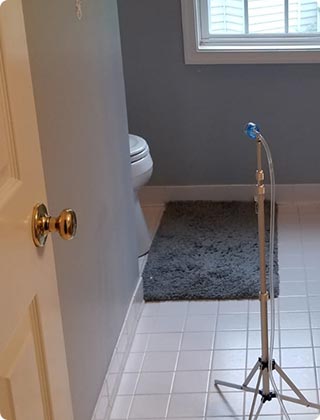What Happens During a Mold Inspection?

A mold inspection is the first and most important step in identifying potential mold problems in a property. It involves a careful, non-invasive assessment of areas where mold is likely to grow - without any laboratory testing or sample collection.
Unlike mold testing, which focuses on identifying the type and quantity of mold spores through lab analysis, a mold inspection is all about finding visible signs of mold, locating sources of moisture, and assessing the conditions that allow mold to thrive.
Why Do You Need a Mold Inspection?
If you already have visible mold or clear signs of it, a mold inspection will help you understand the extent of the problem and provide an estimate for the cost of remediation. This service is not designed to detect hidden mold or confirm mold you suspect but cannot see - for that, professional mold testing would be required. If you're planning a real estate transaction or facing a visible mold issue and want a professional evaluation of what it will take to fix it, a mold inspection is the right first step.
How to Prepare for Inspection
Preparing for a mold inspection is simple but important. A few small steps can help ensure the inspector can complete a thorough and accurate assessment.
Make Key Areas Accessible
Inspectors need clear access to areas where mold is most likely to develop. This includes basements, crawl spaces, attics, under sinks, around windows, and near HVAC systems. Move furniture, boxes, or stored items away from walls and corners so the inspector can examine these spaces without obstacles.
Information to Share
Be ready to point out any specific areas where you've noticed water stains, musty odors, or visible mold. Sharing what you've observed helps the inspector focus on potential problem zones right from the start.
History of Water Damage or Mold
If your property has a history of flooding, roof leaks, pipe bursts, or prior mold problems, let the inspector know. Past water damage, even if repaired, can leave hidden moisture that supports mold growth behind walls or under floors.
Taking a few minutes to prepare your home not only helps the inspection go more smoothly, but it also increases the chances of finding hidden issues that could otherwise be missed. A well-prepared property allows the inspector to deliver a more complete and accurate evaluation.
Step-by-Step: What to Expect During a Mold Inspection
Mold inspections are methodical and non-invasive, focused on identifying visible signs of mold and underlying moisture problems. Here's how the process typically unfolds:
Visual Inspection of Suspected Areas
The inspection begins with a thorough, detailed review of both interior and exterior spaces. The specialist carefully examines areas where mold is most likely to develop, such as bathrooms, kitchens, basements, attics, and around windows and doors. HVAC systems, including vents and air ducts, are also visually checked for any signs of mold buildup or moisture issues.
The goal is to spot visible growth, water stains, discoloration, warped materials, or any structural indicators that mold may be present. Special attention is given to areas that have had past water damage or are prone to high humidity.
Non-Invasive Assessment
A professional mold inspection is strictly non-invasive. Inspectors do not drill into walls, lift flooring, or damage any part of the property during the evaluation.
Using trained observation and professional techniques, they carefully assess accessible areas to detect visible signs of mold or water damage - all without tearing into walls, ceilings, or materials. The focus is on identifying surface clues that point to potential hidden issues.
Moisture Reading for Hidden Mold
During the inspection, moisture meters are used alongside visual observations to detect hidden dampness inside walls, ceilings, and floors. These devices measure the moisture content of building materials without causing any damage.
Moisture detection is a critical part of the inspection process because mold often develops in areas where moisture is trapped but not visible to the eye. Identifying these hidden damp spots helps inspectors locate potential mold growth early and recommend the appropriate actions to address the issue.
Remediation Estimate Based on Findings
At the conclusion of the inspection, if visible mold or conditions favorable to mold growth are found, the inspector will provide an estimate for mold remediation. This estimate is based solely on the visual assessment and moisture readings performed during the inspection - not on lab results or testing.
Receiving an early estimate allows homeowners to address problems before they become more widespread. Quick action can significantly reduce the cost of repairs, minimize potential health risks, and prevent further damage to the property's structure and indoor air quality.
Important Notes About Mold Inspections
It's important to understand that a standard mold inspection does not include laboratory testing or sample analysis unless specifically requested as an additional service.
The primary focus of a mold inspection is to identify visible signs of mold growth and the conditions that support its development, such as hidden moisture or ventilation issues. Inspectors rely on professional observation and moisture detection to form a thorough, non-invasive evaluation of the property.
In many situations, further mold testing is recommended to confirm the presence, type, and concentration of mold spores - especially when there are health concerns, real estate transactions, or when hidden mold is suspected but cannot be confirmed visually. Mold testing can be easily added after the initial inspection to provide a complete and detailed understanding of the indoor environment.
Why Choose O2 Mold Testing for Your Inspection?
At O2 Mold Testing, we bring extensive experience and a careful, professional approach to every mold inspection. Our team is trained to perform thorough, non-invasive evaluations, using advanced moisture detection equipment to uncover hidden issues without damaging your property.
We believe in clear communication at every step. After the inspection, we provide an honest explanation of our findings. Our goal is to give you the information you need to make the best decision for your home or business.
As a local mold inspection company, we also understand the unique building conditions and climate challenges that contribute to mold problems in this region. Our inspectors know where to look, what warning signs to catch early, and how to tailor recommendations based on real-world experience in your area.
Protect Your Home with Early Mold Detection
A professional mold inspection is an important first step toward creating a healthier, safer home. By identifying visible mold growth and the conditions that support it, inspections help homeowners take control before small issues turn into costly repairs.
Early discovery and timely action make all the difference - protecting both your property and your family's well-being.
FAQs
Does a mold inspection guarantee there's no hidden mold?
A mold inspection greatly improves the chances of identifying hidden issues, but no inspection can guarantee that every hidden mold problem will be found without invasive investigation. Inspectors use non-invasive tools and techniques to detect visible signs and hidden moisture, but some deeply concealed mold may remain undetected without further mold testing.
Can I clean visible mold myself after an inspection?
Small areas of surface mold can sometimes be cleaned by homeowners using proper safety precautions and mold-cleaning products. However, if the affected area is large, recurring, or connected to underlying moisture problems, it's recommended to hire professional mold remediation services to ensure safe and complete removal.
How often should I schedule a mold inspection?
For most homes, a mold inspection is recommended every few years as part of regular property maintenance. However, you should schedule an inspection sooner if you notice signs of water damage, experience persistent musty odors, or plan to buy or sell a property.


